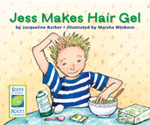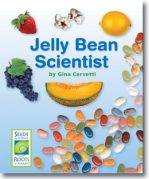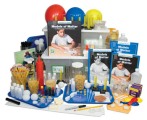Posts tagged ‘books’
Help Students Model the Steps of the Design Process by Making Hair Gel
 In the Seeds of Science/Roots of Reading student book, Jess Makes Hair Gel, students read an account of a boy who sets out to make his own hair gel. Through the book, students have an opportunity to see the design process in action, complete with obstacles, missteps, and successes that Jess encounters.
In the Seeds of Science/Roots of Reading student book, Jess Makes Hair Gel, students read an account of a boy who sets out to make his own hair gel. Through the book, students have an opportunity to see the design process in action, complete with obstacles, missteps, and successes that Jess encounters.
Students learn:
- there are important steps that scientists follow when they design something
- while each step is important, you don’t always need to follow the same exact steps, in the same exact order
- scientists often need to revise their plans as they go along, based on what they learn
In the book, Jess identifies the properties of a good hair gel and then tests different ingredients to see which have these properties. While conducting tests on each ingredient, Jess realizes that he needs to expand the list of properties of good hair gel to include several more. With this realization he is able to solve problems he encounters and end up with a great hair gel.
You can let your students design their own gels. Ask which ingredients they’d like to investigate. Take this opportunity to teach students to use the word substances. Explain that substance is a word scientists use for ingredient. Possible ingredient choices could include: shampoo, shaving cream, egg whites, corn syrup, gelatin and a glue stick (remind students to check with parents to determine the safety of an ingredient).
Share the important steps for designing mixtures.
- Decide on the properties you want your new mixture to have. (more…)
Celebrate Earth’s Rotation Day with Students
Earth’s Rotation Day is January 8th! Recognition of this day is a great way to incorporate a lesson on gravity.
 First, explain to students the importance of this day. On January 8, 1851, physicist Leon Foucault (foo-koh) demonstrated that the Earth rotates on its axis. The device he used to prove this is known as the Foucault’s Pendulum.
First, explain to students the importance of this day. On January 8, 1851, physicist Leon Foucault (foo-koh) demonstrated that the Earth rotates on its axis. The device he used to prove this is known as the Foucault’s Pendulum.
Without any formal scientific training, Foucault had an insight that no scientist before him had figured out. Check out this video that explains how the discovery became a rotation meter.
The pendulum swings freely to and fro under the action of gravity. Once set in motion, it continues to swing back and forth in a vertical plane defined by the track of the ball and cable. Although gravity is pulling down on the ball and tension in the cable is holding it up, there is no force acting to change the direction of swing. Air friction and gravity would eventually stop the pendulum from swinging, but a magnet encircling the cable pulls on the cable with each swing. Electric current controlling the magnetism is turned on and off with each swing of the pendulum.
 Here’s a nice segue to covering the topic of gravity with students. How does gravity affect their everyday life? In the Seeds of Science/Roots of Reading student book Gravity Is Everywhere, students are told they can’t escape gravity. Gravity is a pulling force. Earth pulls on them and everything around them with the force of gravity.
Here’s a nice segue to covering the topic of gravity with students. How does gravity affect their everyday life? In the Seeds of Science/Roots of Reading student book Gravity Is Everywhere, students are told they can’t escape gravity. Gravity is a pulling force. Earth pulls on them and everything around them with the force of gravity.
In the book, students learn that you can measure gravity. Simply measure your weight on a scale to measure the pull of gravity between you and Earth. The stronger the pull, the higher the number will be on a scale. Here’s a fun way to reinforce this concept with students. Show students the objects on the left side of this table and ask them to put in order the objects being pulled most strongly to Earth – from least to greatest. Then reveal the right side which details the weight. Ask them to report on whether their assumptions were correct.
In addition to the concept of measuring gravity, students also learn about gravity in space. Students will find it interesting to learn that if they visited another planet, their weight would be different there. One fun fact to astound them with is what a kid might weigh on the Sun…1,680 pounds! They would weigh about the same on Venus where the gravitational pull is similar to Earth’s. Key science vocabulary covered in Gravity is Everywhere includes: attract, compare, escape, force, gravity, Jupiter, Mars, measure, object, planet, Solar System, table, Universe, Venus and weight.
We hope you have fun celebrating Earth’s Rotation Day! It’s a great excuse to share engaging science concepts with your students.
For more information about the student book Gravity Is Everywhere and the Gravity and Magnetism science and literacy unit, visit http://www.wirelessgeneration.com/curriculum-instruction/seeds-of-science/overview.
Do you want to be notified when we publish new blog articles? Simply enter your email address in the “Follow Blog via Email” box located in the right sidebar.
When I grow up, I want to be a Jelly Belly scientist!
Being a scientist is cool. Being a JELLY BEAN scientist is super cool! Ambrose Lee can attest to this. Ambrose is a food scientist who brainstorms flavor recipes for gourmet jelly beans at Jelly Belly Candy Co. His job is so cool it has been featured in Popular Science magazine. Check out the Jelly Belly web site to learn more about the variety of flavors including crazy ones like:
- Pencil Shavings
- Toothpaste
- Moldy Cheese
- Skunk Spray
Yuck!
The developers of the Seeds of Science/Roots of Reading program were thrilled when Ambrose agreed to be featured in a student book called Jelly Bean Scientist. In the book, readers meet Ambrose and his team of scientists who conduct tests with lab equipment and their own taste buds so the jelly bean flavors they design taste as (more…)




